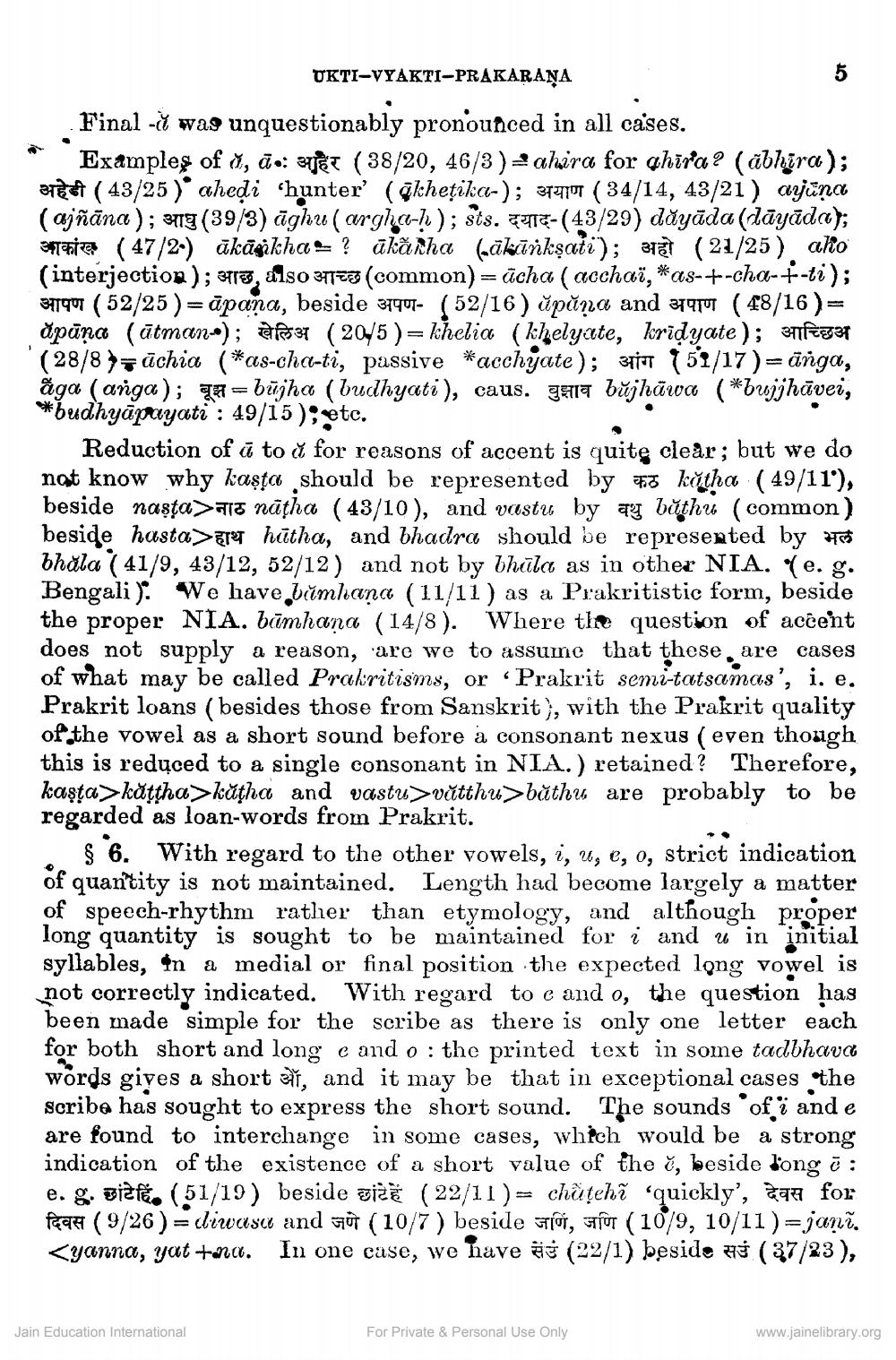________________
UKTI-VYAKTI-PRAKARANA
Final -- was unquestionably pronounced in all cases. * Examples of d, ão: SLET (38/20, 46/3) +ahira for chira? (abhira); BTT ( 43/25) aheời hunter' (akheţika-); 741 (34/14, 43/21) arjuna ( ajñāna); 3719 (39/3) āghu (arghc-); sts. 17-(43/29) dayāda (clāyāda); 377ie (47/2)ākāgikhas ? ākärha (akurksati); stat (21/25) aho (interjection); 31185, also 37773 (common)=ācha (acchaï, *as-to-cha-+-ti); 341901 ( 52/25 ) =āpaņa, beside 31907- (52/16) ăpăna and aparut (48/16 ) = đpāna (ūtmano); afssy (2045 )= khelia (khelyate, krīdyate); lesen '(28/8 75āchia (*as-cha-ti, passive *acchiate); 311 51/17)=ūnga, âga (anga); a=būjha (buidhyati), caus. 9919 bijhāwa (*bujjhāvei, *budhyāpayati : 49/15); etc.
Reduction of ū to ă for reasons of accent is quite clear; but we do not know why kaşta should be represented by Fr kåtha ( 49/11), beside naşta> air nātha (43/10), and vastu by ay buthu (common) beside hasta>97 hūtha, and bhadra should be represented by bhala ( 41/9, 43/12, 52/12) and not by bhala as in other NIA. Ye. g. Bengali). We have båmhanc (11/11) as a Prakritistic form, beside the proper NIA. būmhana (14/8). Where the question of accent does not supply a reason, are we to assume that these are cases of what may be called Prakritisms, or Prakrit semi-tatsamas', i. e. Prakrit loans (besides those from Sanskrit), with the Prakrit quality of the vowel as a short sound before a consonant nexus (even though this is reduced to a single consonant in NIA.) retained? Therefore, kaşta>kattha>kåtha and vastu>vătthu>băthu are probably to be regarded as loan-words from Prakrit.
$ 6. With regard to the other vowels, i, u, 0, 0, strict indication of quantity is not maintained. Length had become largely a matter of speech-rhythm rather than etymology, and although proper long quantity is sought to be maintained for i and u in initial syllables, in a medial or final position the expected long vowel is not correctly indicated. With regard to e and o, the question has been made simple for the scribe as there is only one letter each for both short and long e and o : the printed text in some tadbhavco words gives a short at, and it may be that in exceptional cases the scriba has sought to express the short sound. The sounds of ï and e are found to interchange in some cases, which would be a strong indication of the existence of a short value of the č, beside long 7 : e. g. gift. (51/19) beside yižė (22/11 )= chủțehã "quickly', aaa for feat ( 9/26 ) = diwasu and GU (10/7) beside froi, (10/9, 10/11)=jană. <yanna, yat tona. In one case, we have (22/1) beside af (37/23),
Jain Education International
For Private & Personal Use Only
www.jainelibrary.org




